2014 FIAT GRANDE PUNTO ACTUAL weight
[x] Cancel search: weightPage 120 of 216
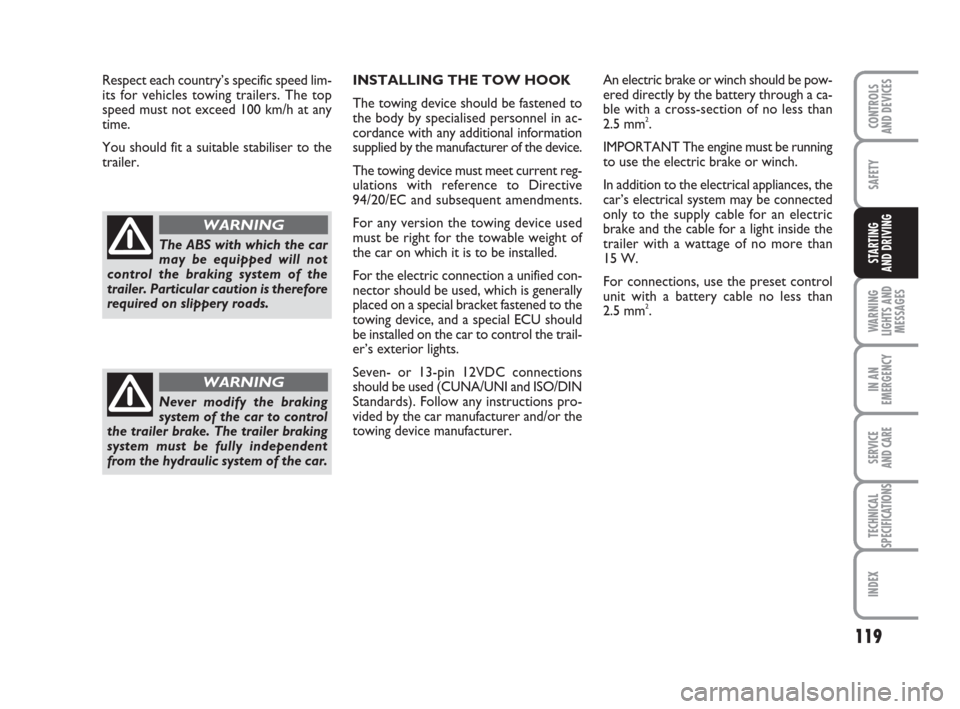
119
SAFETY
WARNING
LIGHTS AND
MESSAGES
IN AN
EMERGENCY
SERVICE
AND CARE
TECHNICAL
SPECIFICATIONS
INDEX
CONTROLS
AND DEVICES
STARTING
AND DRIVING
INSTALLING THE TOW HOOK
The towing device should be fastened to
the body by specialised personnel in ac-
cordance with any additional information
supplied by the manufacturer of the device.
The towing device must meet current reg-
ulations with reference to Directive
94/20/EC and subsequent amendments.
For any version the towing device used
must be right for the towable weight of
the car on which it is to be installed.
For the electric connection a unified con-
nector should be used, which is generally
placed on a special bracket fastened to the
towing device, and a special ECU should
be installed on the car to control the trail-
er’s exterior lights.
Seven- or 13-pin 12VDC connections
should be used (CUNA/UNI and ISO/DIN
Standards). Follow any instructions pro-
vided by the car manufacturer and/or the
towing device manufacturer.An electric brake or winch should be pow-
ered directly by the battery through a ca-
ble with a cross-section of no less than
2.5 mm
2.
IMPORTANT The engine must be running
to use the electric brake or winch.
In addition to the electrical appliances, the
car’s electrical system may be connected
only to the supply cable for an electric
brake and the cable for a light inside the
trailer with a wattage of no more than
15 W.
For connections, use the preset control
unit with a battery cable no less than
2.5 mm
2. Respect each country’s specific speed lim-
its for vehicles towing trailers. The top
speed must not exceed 100 km/h at any
time.
You should fit a suitable stabiliser to the
trailer.
The ABS with which the car
may be equipped will not
control the braking system of the
trailer. Particular caution is therefore
required on slippery roads.
WARNING
Never modify the braking
system of the car to control
the trailer brake. The trailer braking
system must be fully independent
from the hydraulic system of the car.
WARNING
111-122 ACTUAL 1ed EN 20-07-2010 16:10 Pagina 119
Page 139 of 216
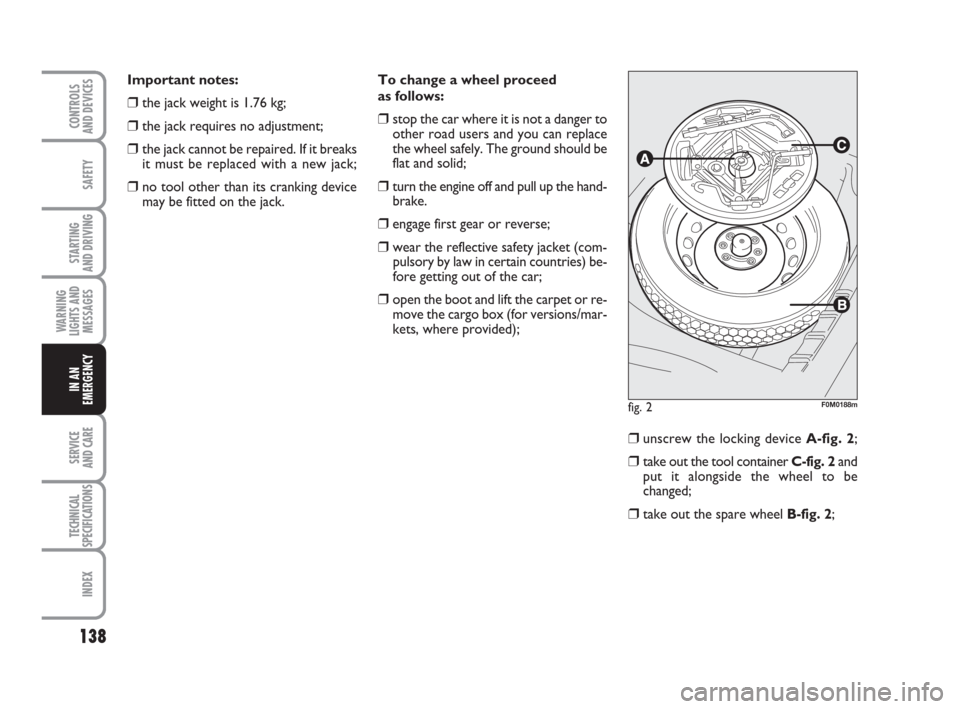
138
SAFETY
STARTING
AND DRIVING
WARNING
LIGHTS AND
MESSAGES
SERVICE
AND CARE
TECHNICAL
SPECIFICATIONS
INDEX
CONTROLS
AND DEVICES
IN AN
EMERGENCY
To change a wheel proceed
as follows:
❒stop the car where it is not a danger to
other road users and you can replace
the wheel safely. The ground should be
flat and solid;
❒turn the engine off and pull up the hand-
brake.
❒engage first gear or reverse;
❒ wear the reflective safety jacket (com-
pulsory by law in certain countries) be-
fore getting out of the car;
❒open the boot and lift the carpet or re-
move the cargo box (for versions/mar-
kets, where provided);
❒unscrew the locking device A-fig. 2;
❒take out the tool container C-fig. 2and
put it alongside the wheel to be
changed;
❒take out the spare wheel B-fig. 2;
fig. 2F0M0188m
Important notes:
❒the jack weight is 1.76 kg;
❒the jack requires no adjustment;
❒the jack cannot be repaired. If it breaks
it must be replaced with a new jack;
❒no tool other than its cranking device
may be fitted on the jack.
135-166 ACTUAL 1ed EN 26-07-2010 16:00 Pagina 138
Page 188 of 216

187
SAFETY
STARTING
AND DRIVING
WARNING
LIGHTS AND
MESSAGES
IN AN
EMERGENCY
SERVICE
AND CARE
INDEX
CONTROLS
AND DEVICES
TECHNICAL
SPECIFICATIONS
IDENTIFICATION DATA ................................................. 188
ENGINE CODES – BODYWORK VERSIONS ............. 184
ENGINE .................................................................................. 191
FUEL SUPPLY ........................................................................ 192
TRANSMISSION .................................................................. 192
BRAKES .................................................................................. 193
SUSPENSIONS ...................................................................... 193
STEERING SYSTEM ............................................................. 193
WHEELS ................................................................................. 194
PERFORMANCES ................................................................ 197
DIMENSIONS ....................................................................... 198
WEIGHTS .............................................................................. 199
CAPACITIES .......................................................................... 201
FLUIDS AND LUBRICANTS ............................................. 202
FUEL CONSUMPTION ...................................................... 204
CO
2EMISSIONS .................................................................. 204
T T
E E
C C
H H
N N
I I
C C
A A
L L
S S
P P
E E
C C
I I
F F
I I
C C
A A
T T
I I
O O
N N
S S
187-204 ACTUAL 1ed EN 26-07-2010 16:08 Pagina 187
Page 189 of 216
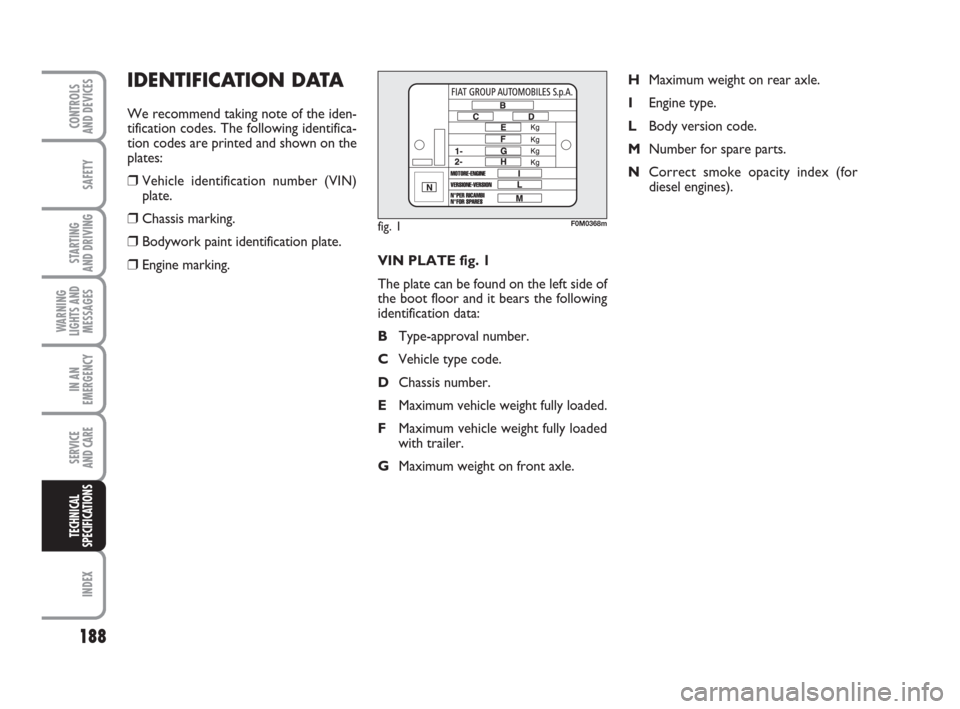
188
SAFETY
STARTING
AND DRIVING
WARNING
LIGHTS AND
MESSAGES
IN AN
EMERGENCY
SERVICE
AND CARE
INDEX
CONTROLS
AND DEVICES
TECHNICAL
SPECIFICATIONS
VIN PLATE fig. 1
The plate can be found on the left side of
the boot floor and it bears the following
identification data:
BType-approval number.
CVehicle type code.
DChassis number.
EMaximum vehicle weight fully loaded.
FMaximum vehicle weight fully loaded
with trailer.
GMaximum weight on front axle.HMaximum weight on rear axle.
IEngine type.
LBody version code.
MNumber for spare parts.
NCorrect smoke opacity index (for
diesel engines).
IDENTIFICATION DATA
We recommend taking note of the iden-
tification codes. The following identifica-
tion codes are printed and shown on the
plates:
❒Vehicle identification number (VIN)
plate.
❒Chassis marking.
❒Bodywork paint identification plate.
❒Engine marking.
fig. 1F0M0368m
187-204 ACTUAL 1ed EN 26-07-2010 16:08 Pagina 188
Page 200 of 216
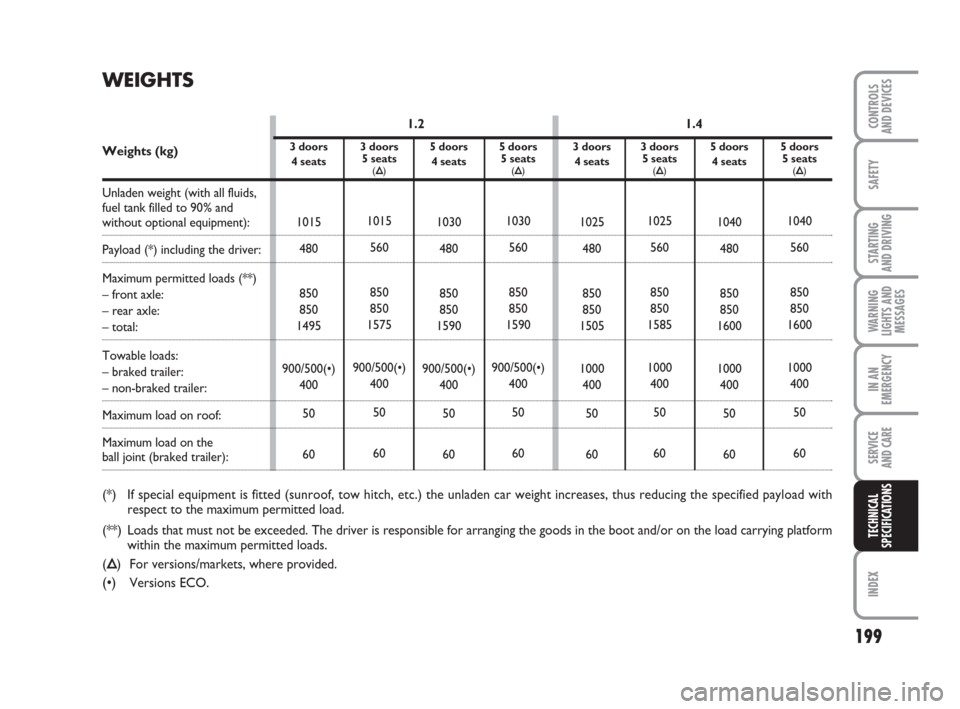
5 doors
4 seats
1030
480
850
850
1590
900/500(•)
400
50
60
5 doors
5 seats
(Õ)
1030
560
850
850
1590
900/500(•)
400
50
60
3 doors
4 seats
1025
480
850
850
1505
1000
400
50
60
3 doors
5 seats
(Õ)
1025
560
850
850
1585
1000
400
50
60
5 doors
4 seats
1040
480
850
850
1600
1000
400
50
60
5 doors
5 seats
(Õ)
1040
560
850
850
1600
1000
400
50
60
3 doors
4 seats
1015
480
850
850
1495
900/500(•)
400
50
60
3 doors
5 seats
(Õ)
1015
560
850
850
1575
900/500(•)
400
50
60
199
SAFETY
STARTING
AND DRIVING
WARNING
LIGHTS AND
MESSAGES
IN AN
EMERGENCY
SERVICE
AND CARE
INDEX
CONTROLS
AND DEVICES
TECHNICAL
SPECIFICATIONS
WEIGHTS
1.2 1.4
Weights (kg)
Unladen weight (with all fluids,
fuel tank filled to 90% and
without optional equipment):
Payload (*) including the driver:
Maximum permitted loads (**)
– front axle:
– rear axle:
– total:
Towable loads:
– braked trailer:
– non-braked trailer:
Maximum load on roof:
Maximum load on the
ball joint (braked trailer):
(*) If special equipment is fitted (sunroof, tow hitch, etc.) the unladen car weight increases, thus reducing the specified payload with
respect to the maximum permitted load.
(**) Loads that must not be exceeded. The driver is responsible for arranging the goods in the boot and/or on the load carrying platform
within the maximum permitted loads.
(Õ) For versions/markets, where provided.
(•)Versions ECO.
187-204 ACTUAL 1ed EN 26-07-2010 16:08 Pagina 199
Page 201 of 216
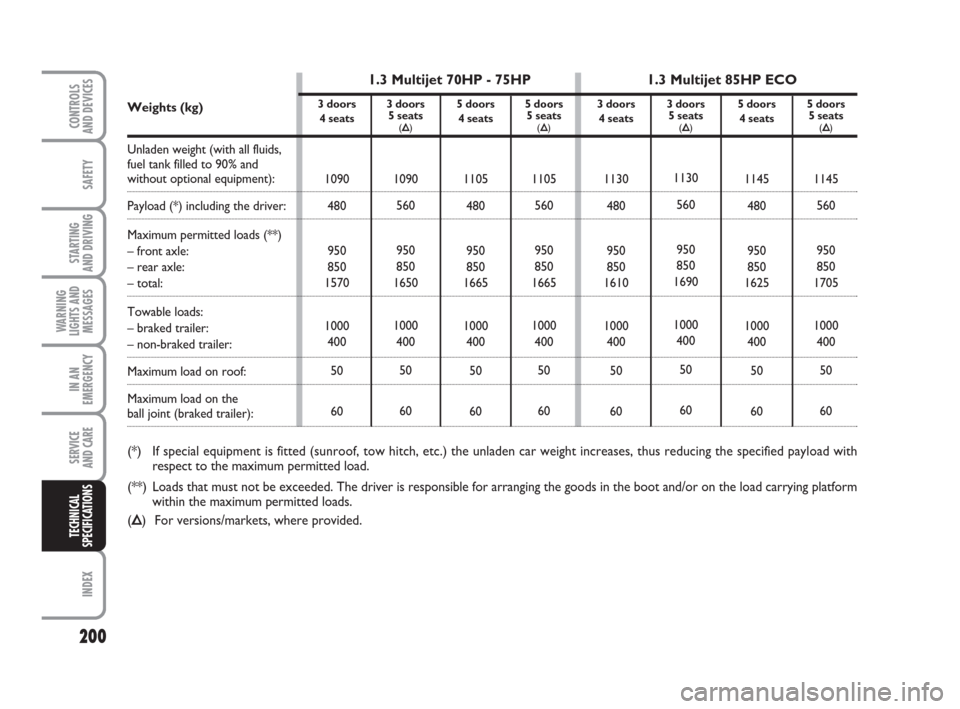
200
SAFETY
STARTING
AND DRIVING
WARNING
LIGHTS AND
MESSAGES
IN AN
EMERGENCY
SERVICE
AND CARE
INDEX
CONTROLS
AND DEVICES
TECHNICAL
SPECIFICATIONS
3 doors
4 seats
1090
480
950
850
1570
1000
400
50
60
3 doors
5 seats
(Õ)
1090
560
950
850
1650
1000
400
50
60
5 doors
4 seats
1105
480
950
850
1665
1000
400
50
60
5 doors
5 seats
(Õ)
1105
560
950
850
1665
1000
400
50
60
3 doors
4 seats
1130
480
950
850
1610
1000
400
50
60
3 doors
5 seats
(Õ)
1130
560
950
850
1690
1000
400
50
60
5 doors
4 seats
1145
480
950
850
1625
1000
400
50
60
5 doors
5 seats
(Õ)
1145
560
950
850
1705
1000
400
50
60
1.3 Multijet 70HP - 75HP 1.3 Multijet 85HP ECO
Weights (kg)
Unladen weight (with all fluids,
fuel tank filled to 90% and
without optional equipment):
Payload (*) including the driver:
Maximum permitted loads (**)
– front axle:
– rear axle:
– total:
Towable loads:
– braked trailer:
– non-braked trailer:
Maximum load on roof:
Maximum load on the
ball joint (braked trailer):
(*) If special equipment is fitted (sunroof, tow hitch, etc.) the unladen car weight increases, thus reducing the specified payload with
respect to the maximum permitted load.
(**) Loads that must not be exceeded. The driver is responsible for arranging the goods in the boot and/or on the load carrying platform
within the maximum permitted loads.
(Õ) For versions/markets, where provided.
187-204 ACTUAL 1ed EN 26-07-2010 16:08 Pagina 200
Page 205 of 216
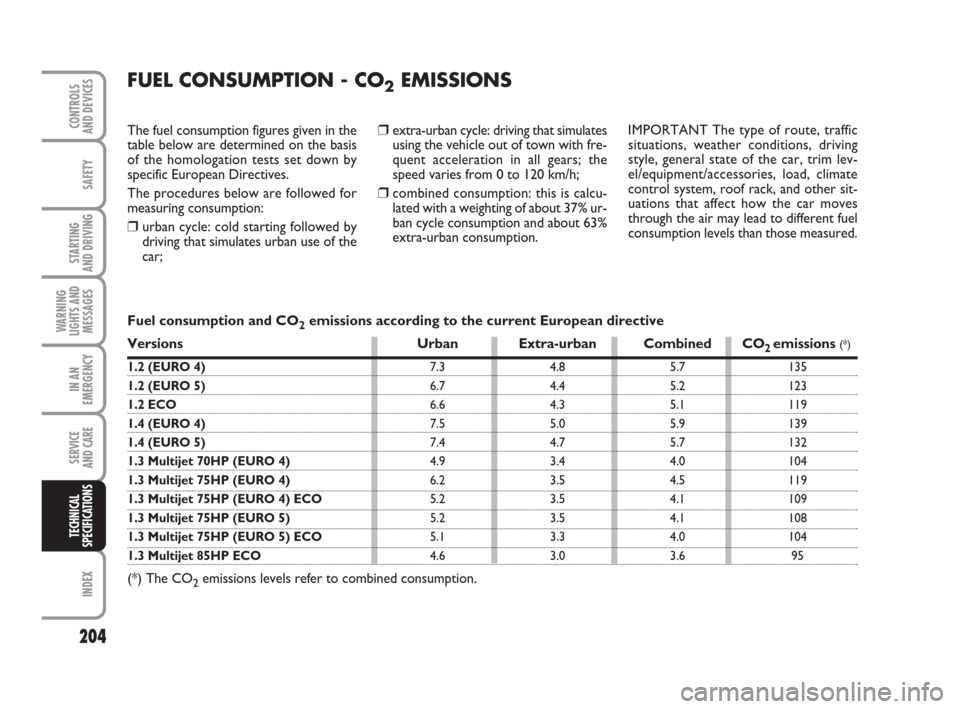
204
SAFETY
STARTING
AND DRIVING
WARNING
LIGHTS AND
MESSAGES
IN AN
EMERGENCY
SERVICE
AND CARE
INDEX
CONTROLS
AND DEVICES
TECHNICAL
SPECIFICATIONS
❒extra-urban cycle: driving that simulates
using the vehicle out of town with fre-
quent acceleration in all gears; the
speed varies from 0 to 120 km/h;
❒combined consumption: this is calcu-
lated with a weighting of about 37% ur-
ban cycle consumption and about 63%
extra-urban consumption. The fuel consumption figures given in the
table below are determined on the basis
of the homologation tests set down by
specific European Directives.
The procedures below are followed for
measuring consumption:
❒urban cycle: cold starting followed by
driving that simulates urban use of the
car;IMPORTANT The type of route, traffic
situations, weather conditions, driving
style, general state of the car, trim lev-
el/equipment/accessories, load, climate
control system, roof rack, and other sit-
uations that affect how the car moves
through the air may lead to different fuel
consumption levels than those measured.
Fuel consumption and CO
2emissions according to the current European directive
Versions Urban Extra-urban Combined CO2 emissions (*)
1.2 (EURO 4)7.3 4.8 5.7 135
1.2 (EURO 5)6.7 4.4 5.2 123
1.2 ECO6.6 4.3 5.1 119
1.4 (EURO 4)7.5 5.0 5.9 139
1.4 (EURO 5)7.4 4.7 5.7 132
1.3 Multijet 70HP (EURO 4)4.9 3.4 4.0 104
1.3 Multijet 75HP (EURO 4)6.2 3.5 4.5 119
1.3 Multijet 75HP (EURO 4) ECO5.2 3.5 4.1 109
1.3 Multijet 75HP (EURO 5)5.2 3.5 4.1 108
1.3 Multijet 75HP (EURO 5) ECO5.1 3.3 4.0 104
1.3 Multijet 85HP ECO4.6 3.0 3.6 95
(*) The CO2emissions levels refer to combined consumption.
FUEL CONSUMPTION - CO2EMISSIONS
187-204 ACTUAL 1ed EN 26-07-2010 16:08 Pagina 204
Page 209 of 216

208
SAFETY
STARTING
AND DRIVING
WARNING
LIGHTS AND
MESSAGES
IN AN
EMERGENCY
SERVICE
AND CARE
TECHNICAL
SPECIFICATIONS
INDEX
CONTROLS
AND DEVICES
Steering ........................................... 193
Steering wheel adjustment ......... 35
Steering wheel lock ...................... 12
Sun visors ....................................... 59
Sunroof ........................................... 60
– emergency operation ............. 61
Suspension ..................................... 193
Symbols ........................................... 6
Technical specifications .............. 187
Third brake light ........................... 153
Tool kit ........................................... 138
Top speeds ..................................... 196
Towing the car .............................. 165
Towing trailers .............................. 118
– installing the tow hook .......... 119
Transmission .................................. 192
Trip computer ............................... 30
Tyre pressures .............................. 196
Tyres
– standard tyres provided ........ 196
– reading tyre markings ............ 194
– maintenance ............................. 181
– pressure .................................... 197
– changing .................................... 137
Tyre Rim Protector....................... 195
Using the manual gearbox ......... 116
Warning lights and messages ... 123
Weights .......................................... 199
Wheel rims
– reading rim markings ............. 195
Wheel trim .................................... 194
Wheels
– trim ............................................ 194
– spare .......................................... 194
– changing .................................... 137
When parked ................................ 115
Window washing .......................... 49
Windows (cleaning) ..................... 185
Windscreen and rear window
wiper blades ................................ 183
Windscreen washer
– control ..................................... 49
– fluid level ................................... 178
Windscreen wipers
– control ..................................... 49
– blades ........................................ 183
– nozzles ...................................... 183
Windscreen/rear window
washer level ................................. 178 – Demanding use of the car .... 173
Side airbags .................................... 107
Side/taillights
– control ...................................... 47
– front bulb replacement .......... 149
– rear bulb replacement ........... 151
Smart washing ............................... 49
Snow chains ................................... 121
Snow tyres ..................................... 196
Socket ............................................. 59
Sound system ................................ 81
Spark plugs
– type ............................................ 191
Speedometer ................................. 14
Starting and driving ....................... 111
Starting the engine
– jump starting ............................ 136
– bump starting ........................... 136
– emergency starting ................. 136
– ignition device ......................... 12
– procedure for petrol
versions ..................................... 112
– procedure for diesel
versions ..................................... 113
– how to warm up the engine
after it has just started .......... 114
– stopping the engine ................ 114
205-214 ACTUAL 1ed EN 26-07-2010 16:15 Pagina 208